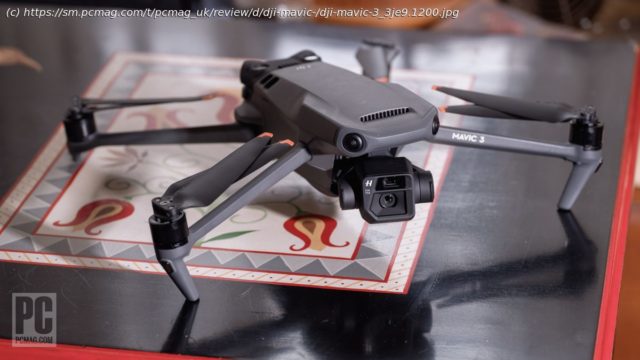The Mavic 3’s Hasselblad camera sets it apart
DJI’s latest drone, the Mavic 3 ($2,199), is the follow-up to a pair of models from 2018, the Mavic 2 Zoom and Mavic 2 Pro. This new quadcopter combines the functions of the two models: It sports a dual-lens camera that nets stunning wide-angle views, along with a telephoto camera for tighter perspectives. The Mavic 3 has some ambitious tech inside, including a Four Thirds format sensor camera with Hasselblad color science and all-around obstacle avoidance sensors. It’s a promising tool for filmmaking and we’re impressed with its 5.1K video so far. We test-flew the drone with beta software, though, so we weren’t able to try out all of its new features. We’re holding off on giving the Mavic 3 a rating at this time, but read on for our first impressions and check back soon for a finalized review. A Four Thirds Camera With Hasselblad Color A slim, folding design defines the drones in DJI’s Mavic line, and the Mavic 3 doesn’t deviate from that formula. It’s a decidedly small aircraft and takes up about the same amount of space in a camera bag as a typical 70-200mm F2.8 zoom lens. Folded for storage it measures 3.6 by 3.8 by 8.4 inches (HWD) and weighs about 2 pounds, heavy enough to require federal registration. DJI Mavic Air 3 folded for storage Recreational pilots flying in the US are required to take the TRUST test before flying, and you’ll need a Part 107 certificate from the FAA to use the Mavic 3, or any UAV, for commercial purposes. For more on what you should know before buying a drone, read our story on drone regulations. The nose-mounted, dual-lens Hasselblad L2D-20c camera is the star here. The large main camera is a 12mm F2.8 backed by a 20MP Four Thirds format sensor (the same size used in Micro Four Thirds mirrorless cameras). It captures the same angle of view as a 24mm on a full-frame system, a focal length that’s now the wide end of standard zooms in the photography world. The dual-lens Hasselblad camera is the star here A second lens sits just above. It has a tighter angle of view, around 162mm in full-frame terms, and is backed by a half-inch sensor, the same size as the main camera in our midrange Editors’ Choice drone, the Mavic Air 2. This lens is used exclusively in Explore mode for media at 7x zoom power and beyond. The camera supports 14x and 28x options as well. Aerial footage is Steadicam-smooth because of the three-axis gimbal camera mount. It keeps the lens steady and level during flight, even when turning and changing altitude. The camera can tilt all the way down to 90 degrees for bird’s-eye views, and supports 35 degrees of upward tilt—a plus for using the drone as a tool for building or bridge inspections, and not without its artistic uses. Standard, Fly More Combo, or Cine? DJI is bringing a few different versions of the Mavic 3 to market. The standard and Fly More Combo use the same aircraft and offer the same flight experience and video capabilities. They’re the models we’re talking about here. DJI includes a harness to protect the camera during transport The $2,199 standard edition includes the drone; a protective cover; a remote control and cables to plug in your phone or tablet; one flight battery; two extra propellers; and a charger. It includes 8GB of onboard storage (not much when you consider the size of 5.1K video files), a microSD slot to expand storage, and a USB-C port for wired transfers. The $2,999 Fly More Combo adds two extra batteries, a three-battery charger, a set of neutral density filters, and two full sets of extra propellers. It ships in a carrying case, one that can convert between a handbag and a backpack. It’s a quality bag and feels sturdy. The zippers aren’t quite the same level of quality as what I’m used to from Peak Design and Think Tank photo bags, however. The carrying case included with the Fly More Combo is well made, but I wish it used better zippers The Cine Premium Combo is sky-high expensive at $4,999, but makes some changes to the flight experience and video capabilities. It has the same accessories as the Fly More package, including the bag. It swaps out the standard remote control for the DJI RC Pro remote; this model sports a built-in display, so you don’t have to connect your phone. More importantly, the Mavic 3 Cine aircraft includes a sizable 1TB SSD, up from the piddling 8GB included in the standard drone. It adds support for higher-quality video compression as well, encoding footage using Apple ProRes 422 HQ codec. The standard Mavic 3 is limited to H.264 and HEVC/H.265 encoding. All-Around Obstacle Avoidance for Safer Flights DJI adds obstacle avoidance sensors to most of its folding drones—counting in-production models, it’s only missing from the basic Mini SE and Mini 2. The Mavic 3 expands the feature, offering an improved version of the all-around sensors from the Mavic 2 Pro and Zoom. Obstacle sensing cameras cover the drone from every angle There are eight sensors in total, two each facing forward, aft, upward, and downward. The front and rear sensors are angled outward, so there’s no need for dedicated port and starboard cameras. The Mavic can sense obstacles coming from any direction. In our first round of testing, it worked as expected, and was accurate enough to warn me of a vulture circling above at one point. DJI says that the sensors can sense objects as far as 656 feet (200 meters) away. Better obstacle detection is good news for safety-conscious pilots. There’s less chance of an accident, and the more sensitive sensors improve automated return-to-home functionality. The drone is better able to map the environment and uses that data to plan a smarter path back home. The Mavic also promises to better navigate autonomously through complex spaces using the Advanced Pilot Assistance System (APAS). Earlier versions of APAS worked well enough to fly around trees at a local park, but DJI promises that APAS 5.0 is much more capable. It showed us footage of the Mavic 3 using it to follow a subject through a very dense cluster of trees. APAS 5.0 wasn’t finished in time for us to test ahead of the Mavic 3’s announcement, but will be available with the final version. We’re eager to see how it compares with the as-yet unparalleled obstacle avoidance in the Skydio 2, especially when combined with DJI’s subject tracking system, Active Track 5.0. Active Track 5.0 isn’t available at launch, either; DJI says that feature will arrive with a firmware update set for January. Those features aren’t the only ones missing at launch. That January update will also include support for two types of automated shots (QuickShots and MasterShots) that let the drone take control over the flight path and its cameras, as well as a 100MP Panorama mode. Downward-facing sensors detect obstacles and help the drone stay steady when flying low to the ground Positioning is solid: The drone gets its location from GPS, GLONASS, and BeiDou satellites, so it knows where it is on the globe and can hover perfectly in place, even with wind.






